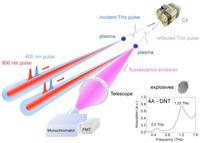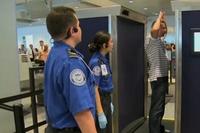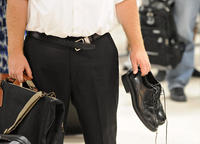-
Terahertz waves for explosives detection

The chips generate and radiate high-frequency electromagnetic waves, called terahertz (THz) waves, which fall into a largely untapped region of the electromagnetic spectrum — between microwaves and far-infrared radiation — and which can penetrate a host of materials without the ionizing damage of X-rays; when incorporated into handheld devices, the new microchips could enable a broad range of applications in fields ranging from homeland security to wireless communications to health care, and even touchless gaming
-
-
Improved technology to detect hazardous chemicals
Scientists have developed a system quickly to detect trace amounts of illegal drugs, explosives, pollutants in rivers, or nerve gases released into the air; the new system can pick out a single target molecule from 10,000 trillion water molecules within milliseconds, by trapping it on a self-assembling single layer of gold nanoparticles
-
-
Mathematicians offer new way for aircraft boarding
Air passenger transportation in China has increased to 200 million in 2010 from less than 10 million in 1950; the increase of the supply of air transportation, however, is much slower than that of its demand; thus, in practice, conflicts between supply and demand often occur, leading to airline congestions, passenger-luggage congestions, and mixed traffic problems; researchers offer a solution to the problem
-
-
Improving the sensitivity of airport security screening
Scientists are reporting a simple way to improve the sensitivity of the test often used to detect traces of explosives on the hands, carry-ons, and other possessions of passengers at airport security screening stations; scientists concluded that swab fabrics could be improved to collect smaller amounts of explosives by peppering them with hydroxyl, phenyl and amine functional groups
-
-
Face-recognition e-Gate at Amsterdam airport moving passengers at rapid pace
E-Gate, the automated border control system developed by Accenture and Vision-Box for the Netherlands Ministry of Internal Affairs, is on target to process its one-millionth passenger at Schiphol Airport in December
-
-
TSA replaces backscatter scanners with millimeter wave scanners at some airports

TSA is replacing some backscatter scanners at large U.S. airports with millimeter wave scanners; backscatter scanners were criticized for violating travelers’ privacy, and risking travelers’ health by emitting high levels of radiation
-
-
CNN commentator complains of inappropriate TSA pat down
A CNN commentator says she was molested by TSA agents when a routine security pat-down ended with federal agents repeatedly touching her private parts and refusing her a public screening
-
-
The human factors in airport security
The capstone event, which will be held in Brussels on 29-30 November, will conclude three years of extensive research conducted in European airports
-
-
Associated Aircraft Group awarded authorization for Reagan National Airport operations
Associated Aircraft Group (AAG), which calls itself the East Coast’s largest executive Sikorsky S-76 helicopter services provider, has been granted access into Ronald Reagan Washington National Airport (DCA) by the Transportation Security Administration (TSA) under the DCA Access Security Program (DASSP)
-
-
Small airports face reduction in TSA funding for security measures
The Transportation Security Administration (TSA) is reducing funding designated to help smaller airports provide law enforcement officers at passenger screenings; since the 9/11 attacks, the TSA mandated that one law enforcement officer be present when commercial passengers are screened at airports; the TSA has now changed the way it circulates funding for this program, reducing the number of hours an officer has to work and the amount he or she will be paid
-
-
Boarding gate with built-in explosives detection speeds up airport security checks

Japanese researchers have developed a boarding gate with built-in explosives detection equipment; the gate collects minute particles which have affixed themselves to IC cards or portable devices used as boarding passes, and can detect within one or two seconds the presence of explosive compounds using internalized equipment; the developers say the gate allows the inspection of 1,200 passengers per hour
-
-
Radiation-enabled computer chips allow low-cost security imaging systems
With homeland security on high alert, screening systems to search for concealed weapons are crucial pieces of equipment; these systems, however, are often prohibitively expensive, putting them out of reach for public spaces such as train and bus stations, stadiums, or malls, where they could be beneficial; until now
-
-
Airbus unveils its 2050 vision for “Smarter Skies”
Global aircraft manufacturer Airbus the other day released the latest installment of the Future by Airbus, its vision for sustainable aviation in 2050 and beyond; the vision looks beyond aircraft design to how the aircraft is operated both on the ground and in the air in order to meet the expected growth in air travel in a sustainable way
-
-
As shoe-scanning devices fail, passengers continue to remove their shoes

In the last five years the U.S. government has tested several scanning devices for detecting explosives and other weapons concealed in the shoes of airline passengers; after spending millions of dollars on these devices, TSA has concluded that the detection systems are ineffective; the result: removing shoes at security check points is going to be a part of air travel for the foreseeable future
-
-
The costs, benefits, and efficiency of aviation security measures
The threat of terrorist attack on American aviation has made the system the focus of intense security efforts, but it is difficult to determine if the benefits outweigh their cost; efficient security policy — a focus on getting the most security for the least cost — should be the priority in an era of fiscal austerity, says a new RAND report
-
More headlines
The long view
New Technology is Keeping the Skies Safe
DHS S&T Baggage, Cargo, and People Screening (BCP) Program develops state-of-the-art screening solutions to help secure airspace, communities, and borders
